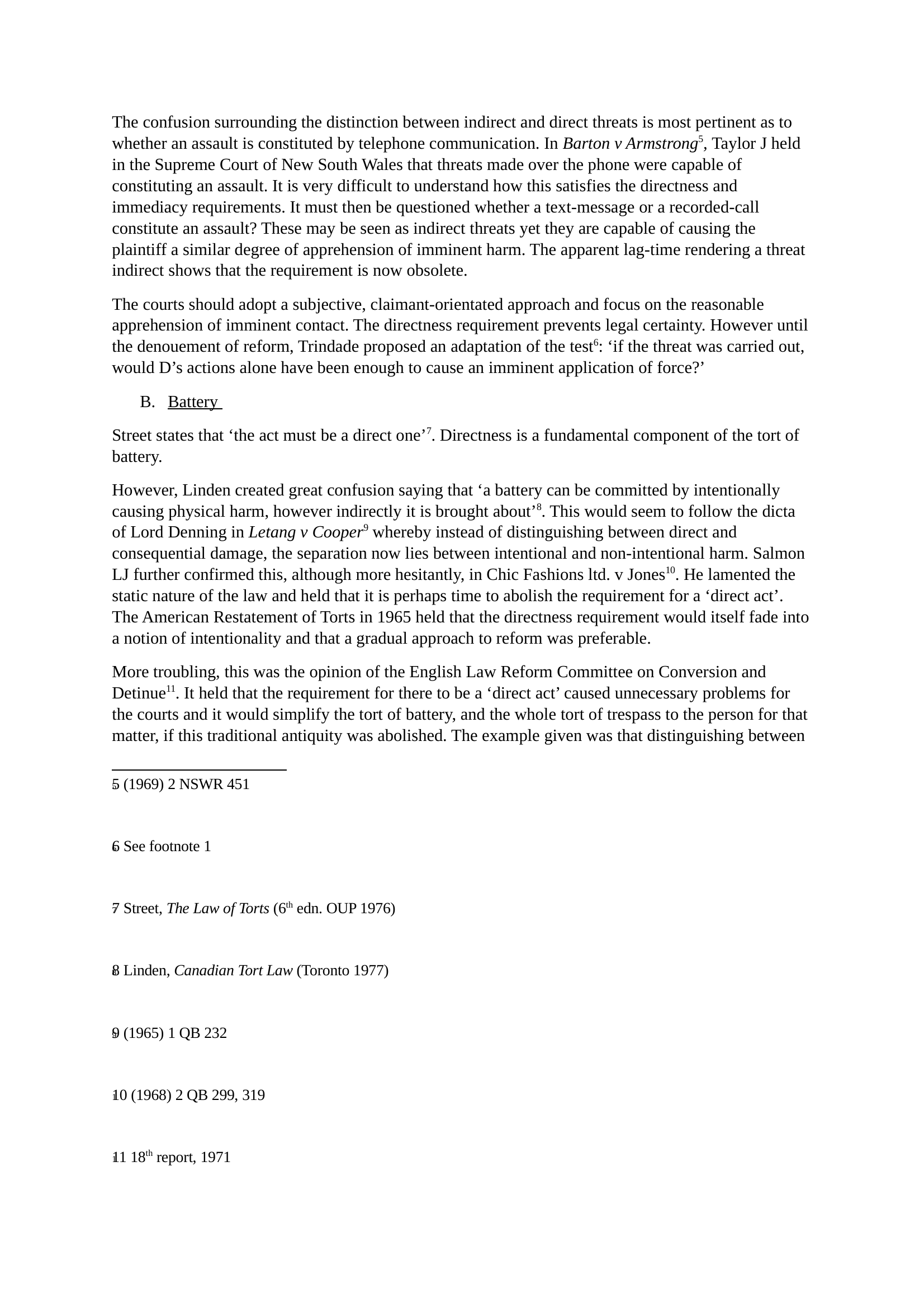The Directness Requirement in Intentional Torts
Publié le 02/12/2014

Extrait du document
«
The confusion surrounding the distinction between indirect and direct threats is most pertinent as to
whether an assault is constituted by telephone communication.
In Barton v Armstrong 5
, Taylor J held
in the Supreme Court of New South Wales that threats made over the phone were capable of
constituting an assault.
It is very difficult to understand how this satisfies the directness and
immediacy requirements.
It must then be questioned whether a text-message or a recorded-call
constitute an assault? These may be seen as indirect threats yet they are capable of causing the
plaintiff a similar degree of apprehension of imminent harm.
The apparent lag-time rendering a threat
indirect shows that the requirement is now obsolete.
The courts should adopt a subjective, claimant-orientated approach and focus on the reasonable
apprehension of imminent contact.
The directness requirement prevents legal certainty.
However until
the denouement of reform, Trindade proposed an adaptation of the test 6
: ‘if the threat was carried out,
would D’s actions alone have been enough to cause an imminent application of force?’
B.
Battery
Street states that ‘the act must be a direct one’ 7
.
Directness is a fundamental component of the tort of
battery.
However, Linden created great confusion saying that ‘a battery can be committed by intentionally
causing physical harm, however indirectly it is brought about’ 8
.
This would seem to follow the dicta
of Lord Denning in Letang v Cooper 9
whereby instead of distinguishing between direct and
consequential damage, the separation now lies between intentional and non-intentional harm.
Salmon
LJ further confirmed this, although more hesitantly, in Chic Fashions ltd.
v Jones 10
.
He lamented the
static nature of the law and held that it is perhaps time to abolish the requirement for a ‘direct act’.
The American Restatement of Torts in 1965 held that the directness requirement would itself fade into
a notion of intentionality and that a gradual approach to reform was preferable.
More troubling, this was the opinion of the English Law Reform Committee on Conversion and
Detinue 11
.
It held that the requirement for there to be a ‘direct act’ caused unnecessary problems for
the courts and it would simplify the tort of battery, and the whole tort of trespass to the person for that
matter, if this traditional antiquity was abolished.
The example given was that distinguishing between
55 (1969) 2 NSWR 451
66 See footnote 1
77 Street, The Law of Torts (6 th
edn.
OUP 1976)
88 Linden, Canadian Tort Law (Toronto 1977)
99 (1965) 1 QB 232
101 (1968) 2 QB 299, 319
111 18 th
report, 1971.
»
↓↓↓ APERÇU DU DOCUMENT ↓↓↓
Liens utiles
- exposé anglais introduction to the Consumer Society
- Le théâtre a-t-il pour fonction de tout dire, de tout expliquer au spectateur de la crise que vivent les personnages? - Par quels moyens et quelles fonctions Juste la Fin du monde est une pièce qui nous retrace la crise de cette famille?
- Ideology and Rationality in the History of the Life Sciences
- is the cultural difference a barrier between individuals.
- Subject: What are the impacts of racism on black people in the United States

































